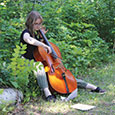Most players who have ordered and purchased a professional model flute have had to decide whether or not to get a C sharp trill key. Beyond the rather high price tag, concerns include added weight, additional imbalance of the flute in terms of rollback, and the usual objection that the C sharp trill key is simply another gadget that can go out of adjustment. In spite of this, the key, once considered an indulgence, now appears much more often on flutes than in the past.
According to Susan J. Maclagan’s A Dictionary for the Modern Flutist, the C# trill key was patented in 1909 by Cornélie Villedieu Laubé, a woodwind inventor who worked in France. Similarly to the Bb side lever, the C# trill key is often neglected as its function is not well understood by flutists. The name does not exactly describe the key’s function and gives no clues as to its versatility. If we were to accurately describe the key, we might call it a B whole-step trill facilitator, but that is a real mouthful. Notwithstanding the fact that trills are usually described by their fundamental note, we can be relieved that at least the key-naming gods did not try to call it a thingy or something, like they did with the gizmo, which should be more correctly called the high C facilitator.
Thriller Triller
Played with the side of the right index finger or the pad of the fingertip, the C# trill key has many useful functions such as:
• Trilling from B to C# in the first and second octaves. Finger B, trill C# key
• Trilling from C to C# in the first and second octaves. Finger C, trill C# key
• Trilling from F# to G# in the top octave. Finger F#, trill C# key
• Trilling from G to Ab in the top octave. Finger G, trill C# key
• Trilling from G to A in the top octave. Finger G, trill C# key and 1st trill
• Trilling from G# to A# in the top octave. Finger G#, trill C# key and 1st and 2nd trill keys
If one is suitably fleet-fingered, trilling the C# trill and the first trill key can work very well in the Mendelssohn Midsummer Night’s Dream Scherzo, for the G to A trill the second bar after B.
Midsummer Night’s Dream, Letter B
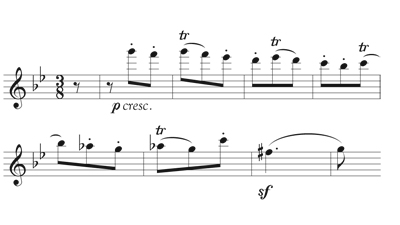
This same right-hand fingering combination (finger C and trill C# trill key and 1st trill key) works well for the second octave C to D trill found in the Dvorák Cello Concerto. Here the trill from C to D in measure 22 is integral to the melodic content of the passage and has a less auxiliary nature than trills usually have. This fingering produces a very suitable D natural with a good tone and excellent intonation. One can find many passages throughout the repertoire in which this trill is useful.
Dvorák Cello Concerto, Bar 18-25 after 6
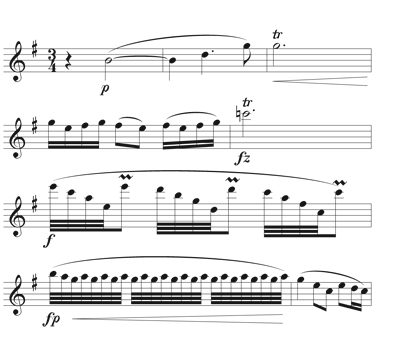
Mojo Tremolo
Beyond the C# trill key’s uses for trills, enough tremolos are made easier with the key to justify its purchase. Generally, any note fingered with the left hand can tremolo to a higher note no more than a perfect fifth above and in the same octave, by using the key either alone or in combination with the trill keys. Excluding trills of a whole or half step, there are at least 27 different commonly occurring tremolos made simpler by using the key.
• Use the C# trill to tremolo from first octave G, Ab, A, and first and second octave Bb to C#5 (and 6).
• Use the C# trill plus the first trill key to tremolo from first and second octave Gb, G, Ab(first octave only), A, Bb, and B to D5 and D6.
• Use the C# trill key plus the first and second trill keys to tremolo from first and second octave G, Ab, A, Bb, B, and C to D#5 and 6.
Here are three examples which demonstrate the utility of the C# trill key for tremolos.
Ibert Concerto for Flute and Orchestra – 4 before 44
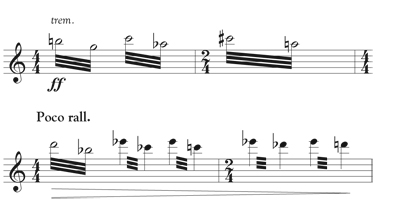
Ibert Concerto for Flute and Orchestra – 4 before 64
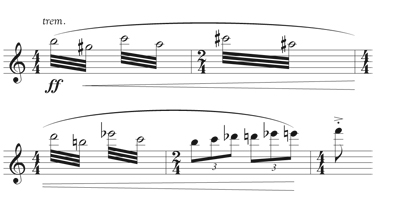
Richard Strauss Ein Heldenleben, Op. 40
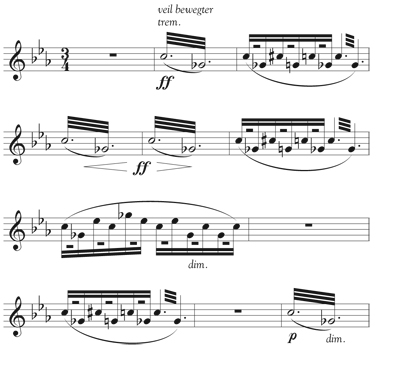
Über C#
One of the best uses of the key is for playing middle C#. If you look around a bit on the internet, you can find references to this use, but I do not think it gets enough attention. The pesky C# in the staff plagues many a flutist daily as left on its own it will be sharp and have a hollow timbre. The C# trill key offers a couple alternatives. Finger a C5 adding the C# trill key for a lovely C# which is in tune at all dynamic levels. This is a particularly useful fingering for making a crescendo and playing at the top dynamic range such as in Edgar Varese Density 21.5.
Edgar Varese Density 21.5, measures 8-11
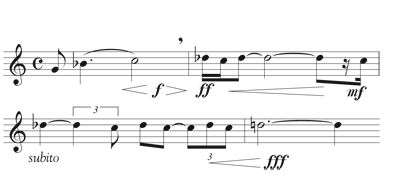
This fingering can also be judiciously used in Claude Debussy’s Prélude à l’après-midi d’un faune. I would caution that this fingering tends to be a bit brilliant in timbre, so I would discourage its use in the opening solo. Throughout the rest of the piece, however, it works well, especially for projection. It is also very useful for passing tones, which may frequently be neglected in terms of tone and intonation, and articulated middle C#’s which can suffer from lack of focus. For passing tones, any time the C# is going to and coming from a note fingered with the left hand, it can be used. The Tchaikovsky Piano Concerto No. 1 is a good example of this.
Pyotr Illyich Tchaikovsky Piano Concerto No. 1, Letter F for 5 bars
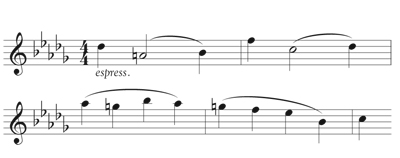
Special Uses
The key can also be used in combination with some standard and harmonic fingerings to negotiate awkward passages, as in this example from Rimsky-Korsakov’s Russian Easter Overture.
Overblow the high A with the standard first octave fingering plus the C# trill key, and alternate with harmonic high F# (standard B fingering in the first octave).
Rimsky-Korsakov Russian Easter Overture, Op. 36, 4 before letter V
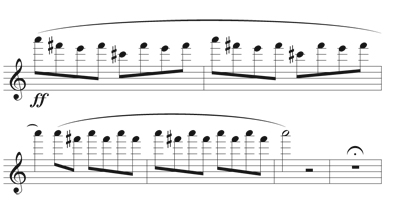
As you have realized by now, I am a fan of the C# trill key. I encourage flutists to include it when buying an instrument and make full use of its many benefits. With a little experimentation, every owner of this smart key can be a more versatile player.


